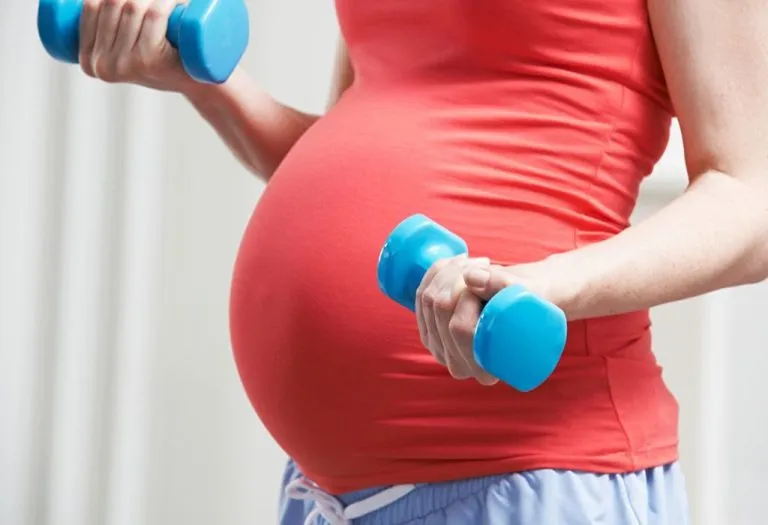Weight Lifting While Pregnant – Benefits, Risks & Safety Tips
Can we lift weight during pregnancy? Well, your body goes through a lot of physical changes during pregnancy. Your uterus expands to make room for the baby and your side and hip joints loosen up to prepare for the delivery. At this point, introducing any new exercise regime that will change your body further or put it under stress is not advisable. But if you have been following a workout regime for a long time before pregnancy, then it will not have any impact on your pregnancy. This article will tell you all about the benefits of weight-lifting and other exercises during normal pregnancy.
Is It Safe to Lift Weights During Pregnancy?
If exercising in the gym and weightlifting is a part of your daily routine, then there is no problem in continuing it during pregnancy too (1). But if you have never done any heavy exercise in the past, then pregnancy is definitely not the time to introduce any new form of exercise in your life.
Even if you are an athlete, you must consult your doctor about whether or not you can continue exercising the way you have been. If you have a normal pregnancy, your doctor may give you a green signal, but if there are any complications in your pregnancy, then your doctor may forbid you to exercise. Weight lifting for pregnant ladies may especially be forbidden, for women who are at risk of premature labour may be asked to stop lifting weights after the first trimester.
Types of Weight Lifting You Can Choose
There are quite a few weight-lifting exercises to choose from during pregnancy. Just ensure that you choose weights that are lighter and will comfortably allow you to perform repetitions. After the first trimester, avoid any exercise while lying on your stomach or on your back.
Here is a list of a few weight-lifting exercises you can do at home or at the gym and their benefits.
- Seated Cable Row and Lat Pull Down for upper and middle back: As your breasts become bigger, your shoulders will tend to slouch forward. This exercise will help you to strengthen the muscles between your shoulder blades that will counter the slump.
- Seated Chest-Press for Chest: This exercise will create muscle balance in the upper body.
- Biceps and Triceps for arms and shoulders: This will help in strengthening your arms and keep them toned.
- Leg Extension and Seated Leg Curl for lower body: As your belly grows, your quadriceps and hamstrings bear the weight of your pregnancy. This exercise will strengthen both.
- Plank for core exercise: This exercise will keep your abs strong and prevent pregnancy-induced back pain.
- Strength Training at Home: For weightlifting exercises and strength training at home, two dumbbells weighing between 3 to 8 pounds are safe weights to lift, a sturdy chair, and a resistance band. You can do 1 or 2 sets of 8 to 12 repetitions of each of the exercises mentioned below.
- Triceps overhead extensions
- Biceps curls
- Lateral raises
- Squats
Please consult your doctor before starting any pregnancy weight workouts at home to ensure that it is safe for you. Remember, all women are different, and all pregnancies are different too!
Benefits of Weight Training in Pregnancy
Weightlifting for pregnant ladies has some amazing benefits for them and can help them through childbirth (2).
- There are many benefits of weight training in early pregnancy. If you exercise by taking all necessary precautions, you will have a shorter labour, fewer complications, shorter hospital stays, lower risk of pre-term birth, and less pain during labour.
- Your baby too will benefit from your weight lifting. Your baby will have stronger blood vessels, will be at minimal risk of suffering from cardiovascular problems, their brain matures faster and they can handle the stress from labour better.
- If you lift weights or exercise under the guidance of a prenatal trainer, you will benefit more from the workouts. The pelvic tilts can help reduce back pain, seated leg curls will prevent any knee pain in the future, and plank exercise will curb back pain during pregnancy.
- Childbirth is a period of great stress for both you and the baby. Weight lifting and other forms of exercise under the supervision of a trainer conditions both of you for the final event. These exercises will season your body, build your confidence and prepare your body to handle stress better.
- Labour is the most strenuous process of pregnancy. It is important that you are prepared for it mentally and physically. Weightlifting, as a part of prenatal exercise, has numerous benefits during labour. It will allow you to focus on your natural movement to make labour easy, it will also help you to align your body for childbirth, and the overall mobility of your muscles will increase.
- Building strength during pregnancy can help your body recover faster after childbirth, making it easier to regain your pre-pregnancy fitness levels.
Dangers of Lifting Heavy Weights
The most common question that is on every pregnant lady’s mind is ‘what happens if we lift weight during pregnancy?’
Lifting heavy weights during pregnancy can be dangerous. Here is why you should avoid lifting heavy weights during pregnancy (3). We will also tell you how much weight can a pregnant woman lift.
- Injuries and Pain: Your muscles, joints, and ligaments are weaker during pregnancy. Hence, you may get hurt easily if you don’t take care. Your lower back has a higher chance of getting injured when lifting heavy weights.
- Falls: As your belly gets bigger, your center of gravity will shift making you more vulnerable to falls. When you bend forward to lift heavy weights, there are high chances of you losing balance and falling. Falling can be very dangerous, especially during the third trimester of pregnancy.
- Reduce the weights: Experts suggest that you must cut down on your weights by 25 percent. Dr Judith Reichman, in an article for NBC News online, suggests that if you were lifting 50 lbs before pregnancy, then during pregnancy you should bring it down to 37.5 lbs. That is how you will decide the safe weight to lift during gestation.
Techniques for Weight-Lifting During Pregnancy
Healthy weight lifting practices during pregnancy are crucial during pregnancy because your skeletal and support system is changing, and you are more prone to problems.
Whenever you lift a weight from the ground, bend at your knees and not at your waist. Also, keep your back as straight as possible while pushing up with your legs to get on your feet. Avoid any jerking or sudden movements while lifting weight during pregnancy. Also, as you progress in the pregnancy, use lighter weights than you did before, cut down on the number of repetitions, use proper breathing techniques (ask your trainer about it), and take breaks in between the exercises.
For First Trimester
Weight lifting during the first trimester can be safe and beneficial if done correctly. In the first trimester, you can try these exercises.
| Muscle Group | Exercise | Sets | Repetitions |
| Back | Lat Pulldown | 2 to 3 | 10 to 15 |
| Shoulders | Shoulder Press | 2 to 3 | 10 to 15 |
| Chest | Dumbbell Chest Press | 2 to 3 | 10 to 15 |
| Biceps | Concentration Curl | 2 to 3 | 10 to 15 |
| Triceps | Lying Tricep Extension | 2 to 3 | 10 to 15 |
| Quads/Glutes | Lunge | 2 to 3 | 10 to 15 |
| Glutes/Hamstring | Stiff-Legged Deadlift | 2 to 3 | 10 to 15 |
| Calves | Calf Raise | 2 to 3 | 10 to 15 |
| Core | Crunch | 2 to 3 | 10 to 15 |
| Core | Plank | 2 to 3 | Timed (e.g., 20-30 sec) |
| Core | Side Bridge | 2 to 3 | Timed (e.g., 20-30 sec) |
For the Second & Third Trimester
During the second and third trimesters, your body undergoes significant changes, including a shift in your centre of gravity and increased joint laxity due to hormonal changes. Below is a table outlining safe and effective weight-lifting techniques for this stage of pregnancy:
| Muscle Group | Exercise | Sets | Repetitions |
| Back | Seated Row | 1 to 3 | 10 to 15 |
| Shoulders | Lateral Raise | 1 to 3 | 10 to 15 |
| Chest | Seated Machine Chest Press | 1 to 3 | 10 to 15 |
| Biceps | Dumbbell Curl | 1 to 3 | 10 to 15 |
| Triceps | Tricep Kickback | 1 to 3 | 10 to 15 |
| Quads/Glutes | Dumbbell Squat | 1 to 3 | 10 to 15 |
| Glutes/Hamstring | Cable Back-Kick | 1 to 3 | 10 to 15 |
| Calves | Standing Calf Raise | 1 to 3 | 10 to 15 |
| Core | Plank | 1 to 3 | 10 to 15 |
| Core | Bird Dog | 1 to 3 | Timed (e.g., 20-30 sec) |
| Core | Side Bridge | 1 to 3 | Timed (e.g., 20-30 sec) |
How Much Weight Can You Lift When Pregnant?
There isn’t a one-size-fits-all answer to this question. Factors like your fitness level before pregnancy, your current exercise routine, and how you’re feeling during pregnancy all play a role. Pay attention to how your body responds and avoid lifting weights that feel overly heavy or cause any discomfort (4). You might notice that the weights you can comfortably handle during pregnancy are lighter than what you’re accustomed to—and that’s perfectly fine. The key is to avoid putting excessive pressure on your abdominal area while lifting.
Weight Training Exercises for Pregnant Women
Athletes or sporting women can benefit from all kinds of pregnancy weights workout. Some of the good options are free weights, resistance training using a resistance training machine and resistance bands, and simple weight training while pregnant using your body weight. All these exercises strengthen your muscles and keep you fit throughout the pregnancy.
Tips for Weight Training in Pregnancy
Irrespective of what regime you pick, it is important to remember that you need to keep decreasing the intensity of your workout as the pregnancy progresses. Here are a few tips for weight training during the three trimesters.
1. First Trimester
The first trimester is all about exhaustion, unpredictable nausea, and mood swings. To keep your mind relaxed and diverted you can continue with a mild workout and weight lifting regime.
It is advisable to carry on with your regular weight training in early pregnancy but review your techniques. Use slow and controlled movements while lifting weights. Don’t get carried away in the momentum as sudden movements and jerks and could the developing fetus. Also, it is important that you continue to breathe throughout the weightlifting exercise and keep the pelvic floor firm.
2. Second Trimester
The preferred position for weightlifting during the second trimester should be a seated position. Standing for too long without moving around can make blood pool in your legs. Lying on your back after the 16th week is not recommended as it may put pressure on one of your veins called the vena cava. Standing or lying on your back after the 16th week can make you dizzy and weak. There are also chances that you may develop varicose veins during this phase. If you notice the development of varicose veins, then be sure to wear support stockings under your workout pants.
If you have any weightlifting exercise in a standing position, then arch or flatten your back so that you don’t lose your balance due to the growing bump. Also, you can move around and vary your positions while weight lifting to avoid aches and pains. Remember the thumb rule: tighten your pelvic floor muscles and breathe normally.
3. Third Trimester
As you progress in the pregnancy, you will have to cut down on repetitions and reduce the weights. You will also have to change your exercise routine as your bump will come in the way of many types of equipment. You can try free weights.
The use of resistant bands is advisable during the third trimester. Be careful while lifting and replacing weights as there is an elevated risk of you dropping them on your bump.
Lifting weights over the head, and with arms outstretched is a no during the last few months of gestation. It may strain your back and that can be super risky. Also, avoid lifting weights from the floor.
It’s is going to get harder during the last trimester to carry on with weightlifting exercises due to the growing bump and the risk of losing balance and falling over. So, take extra care and stick to light weights and very simple exercises. Ensure that you always have a prenatal trainer around you while you indulge in your exercise routine.
Weight Lifting Exercises to Avoid During Pregnancy
Weight lifting can still be part of your fitness regimen during pregnancy, but certain exercises should be avoided to reduce the risk of injury or strain. Below are some weight-lifting exercises to steer clear of during pregnancy, along with safer alternatives.
- Heavy Deadlifts: Avoid heavy deadlifts, especially as your pregnancy progresses. The strain on your lower back and the risk of losing balance increase as your centre of gravity shifts.
- Overhead Presses: Lifting heavy weights overhead can put unnecessary pressure on your abdominal area and lower back. It may also compromise your balance.
- Lying Flat on Your Back (e.g., Bench Press): After the first trimester, avoid exercises that require lying flat on your back, as this can restrict blood flow to the uterus.
- Twisting or Rotational Movements: Exercises like Russian twists or weighted torso rotations can strain your abdominal muscles and pelvic area, which are already under stress during pregnancy.
FAQs
1. Can weight lifting cause Diastasis Recti during pregnancy?
While weight lifting itself doesn’t directly cause diastasis recti (separation of abdominal muscles) (5), improper form or excessive strain on the core can worsen the condition. Focus on exercises that strengthen the transverse abdominis and avoid movements that cause your belly to cone or bulge.
2. Is it safe to lift heavy weights if I was a powerlifter before pregnancy?
If you were a powerlifter or regularly lifted heavy weights before pregnancy, you may continue with caution, but it’s essential to reduce intensity and avoid maximal lifts. Consult your healthcare provider and work with a prenatal trainer to adjust your routine for safety.
3. Can weight lifting trigger Braxton Hicks contractions?
Intense physical activity, including heavy lifting, can sometimes trigger Braxton Hicks contractions (false labour pains). If you experience frequent or painful contractions, stop exercising and consult your doctor.
This was all about lifting weights and pregnancy. With an extensive list of benefits, safe weight training during pregnancy is more of a boon than a curse. But this is only applicable to women who are already into weight training way before pregnancy. Starting weight training or any other new form of exercise during pregnancy is not recommended. All you need to do is take it easy, consult your doctor, work out under the supervision of a prenatal trainer, vary your exercise routine, focus on different muscle groups, use lighter weights, keep your breathing steady and listen to your body. As long as you take care, pregnancy weight training will help you to tone up, improve your posture, strengthen your muscles and make labour easier.
References/Resources:
1. Office of Disease Prevention and Health Promotion – Stay Active During Pregnancy: Quick Tips
3. National Library of Medicine – Pregnancy And Exercise
4. Better Health Channel – Pregnancy and exercise
5. Cleveland Clinic – Diastasis Recti
Also Read:
Activities to Avoid in Pregnancy
Household Work To Do & Avoid In Pregnancy
Exercises You Should Avoid When Pregnant
Best Standing & Sitting Positions in Pregnancy
Was This Article Helpful?
Parenting is a huge responsibility, for you as a caregiver, but also for us as a parenting content platform. We understand that and take our responsibility of creating credible content seriously. FirstCry Parenting articles are written and published only after extensive research using factually sound references to deliver quality content that is accurate, validated by experts, and completely reliable. To understand how we go about creating content that is credible, read our editorial policy here.






















